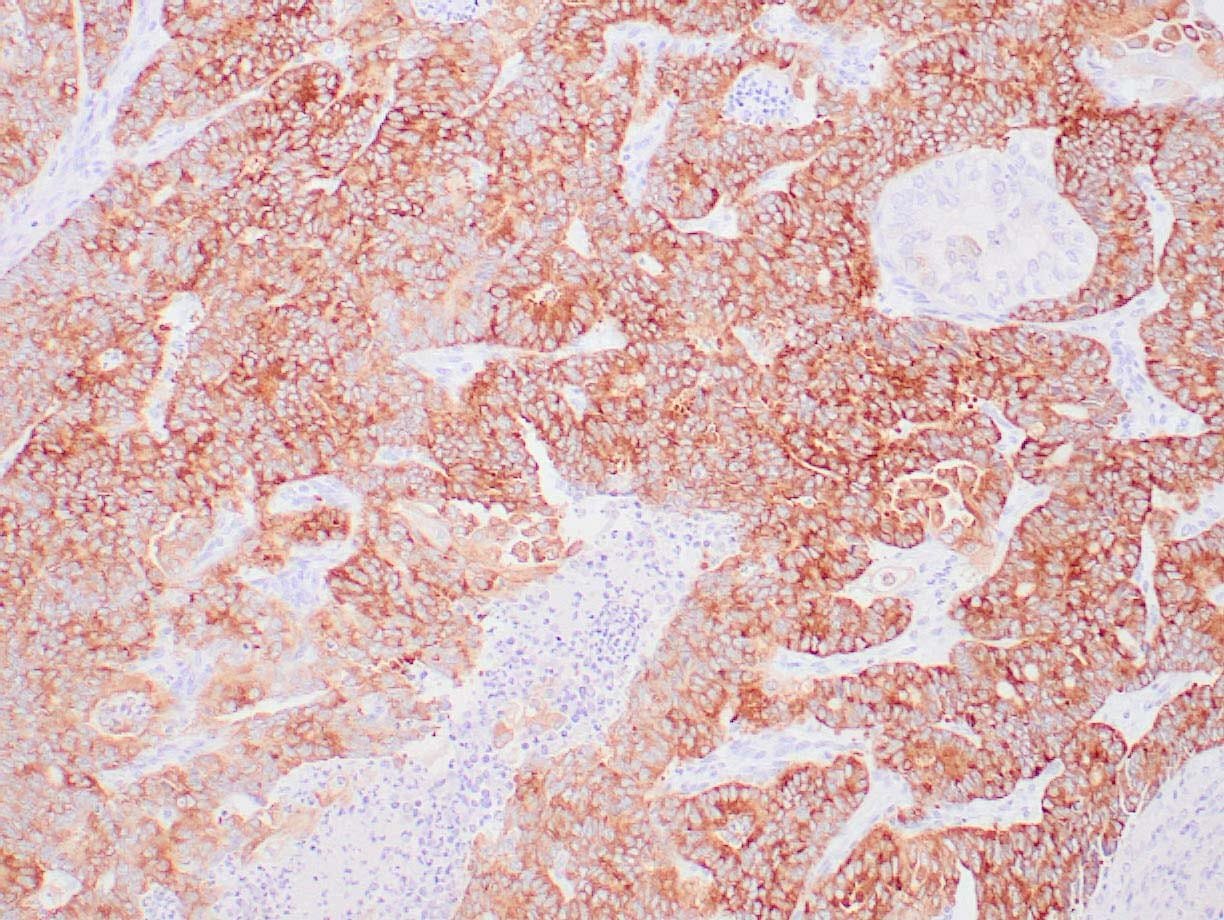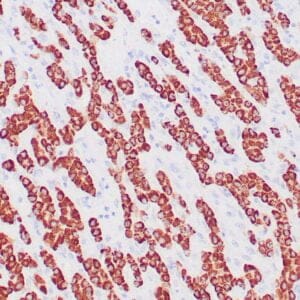| Weight | 1 lbs |
|---|---|
| Dimensions | 9 × 5 × 2 in |
| host | mouse |
| isotype | IgG |
| clonality | monoclonal |
| concentration | concentrate, predilute |
| applications | IHC |
| reactivity | human |
| available size | 0.1 mL, 0.5 mL, 1 mL concentrated, 7 mL prediluted |
rabbit anti-IMP-3 monoclonal antibody (EP286) 6227
Price range: $160.00 through $528.00
Antibody summary
- Rabbit monoclonal to IMP-3
- Suitable for: Immunohistochemistry (formalin-fixed, paraffin-embedded tissues)
- Reacts with: Human
- Isotype:IgG
- Control: Pancreatic ductal adenocarcinoma
- Visualization: Cytoplasmic
- 0.1, 0.5, 1.0 mL concentrated, 7 mL prediluted
rabbit anti-IMP-3 monoclonal antibody EP286 6227
| target relevance |
|---|
| Protein names Insulin-like growth factor 2 mRNA-binding protein 1 (IGF2 mRNA-binding protein 1) (IMP-1) (IMP1) (Coding region determinant-binding protein) (CRD-BP) (IGF-II mRNA-binding protein 1) (VICKZ family member 1) (Zipcode-binding protein 1) (ZBP-1) |
| Gene names IGF2BP1,IGF2BP1 CRDBP VICKZ1 ZBP1 |
| Protein family RRM IMP/VICKZ family |
| Mass 63481Da |
| Function FUNCTION: RNA-binding factor that recruits target transcripts to cytoplasmic protein-RNA complexes (mRNPs). This transcript 'caging' into mRNPs allows mRNA transport and transient storage. It also modulates the rate and location at which target transcripts encounter the translational apparatus and shields them from endonuclease attacks or microRNA-mediated degradation. Preferentially binds to N6-methyladenosine (m6A)-containing mRNAs and increases their stability (PubMed:29476152, PubMed:32245947). Plays a direct role in the transport and translation of transcripts required for axonal regeneration in adult sensory neurons (By similarity). Regulates localized beta-actin/ACTB mRNA translation, a crucial process for cell polarity, cell migration and neurite outgrowth. Co-transcriptionally associates with the ACTB mRNA in the nucleus. This binding involves a conserved 54-nucleotide element in the ACTB mRNA 3'-UTR, known as the 'zipcode'. The RNP thus formed is exported to the cytoplasm, binds to a motor protein and is transported along the cytoskeleton to the cell periphery. During transport, prevents ACTB mRNA from being translated into protein. When the RNP complex reaches its destination near the plasma membrane, IGF2BP1 is phosphorylated. This releases the mRNA, allowing ribosomal 40S and 60S subunits to assemble and initiate ACTB protein synthesis. Monomeric ACTB then assembles into the subcortical actin cytoskeleton (By similarity). During neuronal development, key regulator of neurite outgrowth, growth cone guidance and neuronal cell migration, presumably through the spatiotemporal fine tuning of protein synthesis, such as that of ACTB (By similarity). May regulate mRNA transport to activated synapses (By similarity). Binds to and stabilizes ABCB1/MDR-1 mRNA (By similarity). During interstinal wound repair, interacts with and stabilizes PTGS2 transcript. PTGS2 mRNA stabilization may be crucial for colonic mucosal wound healing (By similarity). Binds to the 3'-UTR of IGF2 mRNA by a mechanism of cooperative and sequential dimerization and regulates IGF2 mRNA subcellular localization and translation. Binds to MYC mRNA, in the coding region instability determinant (CRD) of the open reading frame (ORF), hence preventing MYC cleavage by endonucleases and possibly microRNA targeting to MYC-CRD (PubMed:29476152). Binding to MYC mRNA is enhanced by m6A-modification of the CRD (PubMed:29476152). Binds to the 3'-UTR of CD44 mRNA and stabilizes it, hence promotes cell adhesion and invadopodia formation in cancer cells. Binds to the oncofetal H19 transcript and to the neuron-specific TAU mRNA and regulates their localizations. Binds to and stabilizes BTRC/FBW1A mRNA. Binds to the adenine-rich autoregulatory sequence (ARS) located in PABPC1 mRNA and represses its translation. PABPC1 mRNA-binding is stimulated by PABPC1 protein. Prevents BTRC/FBW1A mRNA degradation by disrupting microRNA-dependent interaction with AGO2. Promotes the directed movement of tumor-derived cells by fine-tuning intracellular signaling networks. Binds to MAPK4 3'-UTR and inhibits its translation. Interacts with PTEN transcript open reading frame (ORF) and prevents mRNA decay. This combined action on MAPK4 (down-regulation) and PTEN (up-regulation) antagonizes HSPB1 phosphorylation, consequently it prevents G-actin sequestration by phosphorylated HSPB1, allowing F-actin polymerization. Hence enhances the velocity of cell migration and stimulates directed cell migration by PTEN-modulated polarization. Interacts with Hepatitis C virus (HCV) 5'-UTR and 3'-UTR and specifically enhances translation at the HCV IRES, but not 5'-cap-dependent translation, possibly by recruiting eIF3. Interacts with HIV-1 GAG protein and blocks the formation of infectious HIV-1 particles. Reduces HIV-1 assembly by inhibiting viral RNA packaging, as well as assembly and processing of GAG protein on cellular membranes. During cellular stress, such as oxidative stress or heat shock, stabilizes target mRNAs that are recruited to stress granules, including CD44, IGF2, MAPK4, MYC, PTEN, RAPGEF2 and RPS6KA5 transcripts. {ECO:0000250, ECO:0000269|PubMed:10875929, ECO:0000269|PubMed:16356927, ECO:0000269|PubMed:16541107, ECO:0000269|PubMed:16778892, ECO:0000269|PubMed:17101699, ECO:0000269|PubMed:17255263, ECO:0000269|PubMed:17893325, ECO:0000269|PubMed:18385235, ECO:0000269|PubMed:19029303, ECO:0000269|PubMed:19541769, ECO:0000269|PubMed:19647520, ECO:0000269|PubMed:20080952, ECO:0000269|PubMed:22279049, ECO:0000269|PubMed:29476152, ECO:0000269|PubMed:32245947, ECO:0000269|PubMed:8132663, ECO:0000269|PubMed:9891060}. |
| Subellular location SUBCELLULAR LOCATION: Nucleus. Cytoplasm {ECO:0000269|PubMed:17289661}. Cytoplasm, perinuclear region. Cytoplasm, P-body {ECO:0000269|PubMed:29476152}. Cytoplasm, Stress granule {ECO:0000269|PubMed:17101699, ECO:0000269|PubMed:29476152}. Cell projection, lamellipodium. Cell projection, dendrite {ECO:0000250}. Cell projection, dendritic spine {ECO:0000250}. Cell projection, growth cone. Cell projection, filopodium {ECO:0000250}. Cell projection, axon {ECO:0000250}. Note=In the nucleus, located in discrete foci, coinciding with the sites of ACTB transcription (By similarity). In the cytoplasm, localizes in cytoplasmic mRNP granules. Colocalizes with microtubules in growth cone filopodia and along neurites in neuronal cells (By similarity). Cytoplasmic colocalization with ACTB mRNA is partially lost at the cell periphery, suggesting release of the transcript. In neuronal processes, exhibits fast retrograde and anterograde movements, when associated with ACTB mRNA; this motility is lost when the association is inhibited (By similarity). In hippocampal neurons, predominantly located within dendrites, particularly at dendritic branching points in young cells, compared to axons (By similarity). In axons, predominantly found in axonal branches and their growth cones (By similarity). In motile cells, such as migrating fibroblasts, localizes to leading edges where it colocalizes with microtubules and microfilaments and to retracting tails (By similarity). Dendritic levels are regulated by neuronal activity and glutaminergic signals: they are increased by KCl-induced depolarization, which induces rapid efflux from the cell body into dendrites, and decreased by the NMDA receptor agonist (By similarity). In motile cells, transported towards the leading edge into the cortical region of the lamellipodia where it is connected to microfilaments (By similarity). In response to cellular stress, such as oxidative stress or heat shock, recruited to stress granules, but not to processing bodies. {ECO:0000250}. |
| Tissues TISSUE SPECIFICITY: Mainly expressed in the embryo, including in fetal liver, fetal lung, fetal kidney, fetal thymus (at protein level). Also expressed follicles of ovary, as well as in gonocytes of testis, spermatogonia, semen, oocytes and placenta (at protein level). Expressed in various cancers, including testis and lung cancers (at protein level), as well as kidney, prostate and trachea cancers. {ECO:0000269|PubMed:12921532, ECO:0000269|PubMed:16049158, ECO:0000269|PubMed:17255263, ECO:0000269|PubMed:9891060}. |
| Structure SUBUNIT: Can form homodimers and heterodimers with IGF2BP1 and IGF2BP3. Component of the coding region determinant (CRD)-mediated complex, composed of DHX9, HNRNPU, IGF2BP1, SYNCRIP and YBX1. During HCV infection, identified in a HCV IRES-mediated translation complex, at least composed of EIF3C, IGF2BP1, RPS3 and HCV RNA-replicon. Interacts (via the KH domains) with HIV-1 GAG (via the second zinc finger motif of NC). Associates (via the RRM domains and KH domains) with HIV-1 particles. Identified in a mRNP complex, composed of at least DHX9, DDX3X, ELAVL1, HNRNPU, IGF2BP1, ILF3, PABPC1, PCBP2, PTBP2, STAU1, STAU2, SYNCRIP and YBX1. Identified in a IGF2BP1-dependent mRNP granule complex containing untranslated mRNAs. Interacts with DHX9, ELAVL2, HNRNPA2B1, HNRNPC, HNRNPH1, HNRNPU, IGF2BP2, ILF2, and YBX1. Interacts with FMR1. Component of a multisubunit autoregulatory RNP complex (ARC), at least composed of IGF2BP1, PABPC1 and CSDE1/UNR. Directly interacts with PABPC1 (PubMed:17212783, PubMed:29476152, PubMed:32245947). Component of a TAU mRNP complex, at least composed of IGF2BP1, ELAVL4 and G3BP. Interacts with ELAVL4 in an RNA-dependent manner. Associates with microtubules and polysomes. Interacts with AGO1 and AGO2. Interacts with ELAVL1 and MATR3 (PubMed:29476152, PubMed:32245947). Interacts (via KH3 and KH4 domains) with SEPIN14P20 peptide RBRP; the interaction results in increased binding of IGF2BP1 to N6-methyladenosine (m6A)-containing mRNAs (PubMed:32245947). {ECO:0000269|PubMed:15282548, ECO:0000269|PubMed:15314207, ECO:0000269|PubMed:16356927, ECO:0000269|PubMed:17212783, ECO:0000269|PubMed:17289661, ECO:0000269|PubMed:17932509, ECO:0000269|PubMed:18385235, ECO:0000269|PubMed:19029303, ECO:0000269|PubMed:19541769, ECO:0000269|PubMed:23640942, ECO:0000269|PubMed:29476152, ECO:0000269|PubMed:32245947}. |
| Post-translational modification PTM: Phosphorylated at Ser-181 by mTORC2 cotranslationally, promoting binding to the 3'-UTR of IGF2 mRNA. {ECO:0000250|UniProtKB:O88477}. |
| Domain DOMAIN: Domains KH3 and KH4 are the major RNA-binding modules, although KH1 and KH2 may also contribute (PubMed:29476152). KH1 and KH2, and possibly KH3 and KH4, promote the formation of higher ordered protein-RNA complexes, which may be essential for IGF2BP1 cytoplasmic retention. KH domains are required for RNA-dependent homo- and heterooligomerization and for localization to stress granules. KH3 and KH4 mediate association with the cytoskeleton. Two nuclear export signals (NES) have been identified in KH2 and KH4 domains, respectively. Only KH2 NES is XPO1-dependent. Both NES may be redundant, since individual in vitro mutations do not affect subcellular location of the full-length protein. The 4 KH domains are important to suppress HIV-1 infectivity. {ECO:0000269|PubMed:20080952, ECO:0000269|PubMed:29476152}. |
| Target Relevance information above includes information from UniProt accession: Q9NZI8 |
| The UniProt Consortium |
Data
 |
| Human pancreatic ductal adenocarcinoma stained with anti-IMP3 antibody using peroxidase-conjugate and DAB chromogen. Note cytoplasmic staining of tumor cells. |
Publications
| pmid | title | authors | citation |
|---|---|---|---|
| We haven't added any publications to our database yet. | |||
Protocols
| relevant to this product |
|---|
| IHC |
Documents
| # | SDS | Certificate | |
|---|---|---|---|
| Please enter your product and batch number here to retrieve product datasheet, SDS, and QC information. | |||
Only logged in customers who have purchased this product may leave a review.















Reviews
There are no reviews yet.